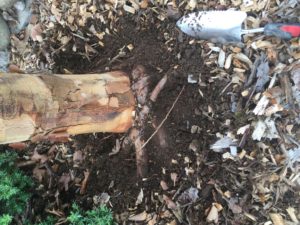Pest Alert – Girdling Roots: Hidden and Silent Killer of Trees
go.ncsu.edu/readext?704462
en Español / em Português
El inglés es el idioma de control de esta página. En la medida en que haya algún conflicto entre la traducción al inglés y la traducción, el inglés prevalece.
Al hacer clic en el enlace de traducción se activa un servicio de traducción gratuito para convertir la página al español. Al igual que con cualquier traducción por Internet, la conversión no es sensible al contexto y puede que no traduzca el texto en su significado original. NC State Extension no garantiza la exactitud del texto traducido. Por favor, tenga en cuenta que algunas aplicaciones y/o servicios pueden no funcionar como se espera cuando se traducen.
Português
Inglês é o idioma de controle desta página. Na medida que haja algum conflito entre o texto original em Inglês e a tradução, o Inglês prevalece.
Ao clicar no link de tradução, um serviço gratuito de tradução será ativado para converter a página para o Português. Como em qualquer tradução pela internet, a conversão não é sensivel ao contexto e pode não ocorrer a tradução para o significado orginal. O serviço de Extensão da Carolina do Norte (NC State Extension) não garante a exatidão do texto traduzido. Por favor, observe que algumas funções ou serviços podem não funcionar como esperado após a tradução.
English
English is the controlling language of this page. To the extent there is any conflict between the English text and the translation, English controls.
Clicking on the translation link activates a free translation service to convert the page to Spanish. As with any Internet translation, the conversion is not context-sensitive and may not translate the text to its original meaning. NC State Extension does not guarantee the accuracy of the translated text. Please note that some applications and/or services may not function as expected when translated.
Collapse ▲One of the most common reasons trees die are the effects of girdling roots. Girdling roots are roots that wrap around the trunk of the tree at the root collar where the roots meet trunk. As the trunk and the root gets larger in diameter, the water carrying wood in the trunk is choked off. We see this hidden problem quite often when we are inspecting sick trees.

Maples like this paperbark maple in the Extension Teaching Garden commonly develop girdling roots which can eventually kill the tree.
Causes of Girdling Roots
Girdling roots can start at the nursery. Before purchasing trees take them out of the pot and inspect the base of the trunk or root collar where the trunk meets the roots. You might see a root that has wrapped itself around the tree and is girdling or choking it.

Girdling roots can lead to dead branches in the canopy. Usually these dead limbs are directly above the girdling root. The girdling root has cut off the flow of water up from the root system.
Another cause of girdling roots is improper tree planting. Many times we find trees that someone has planted without taking off the wire basket, burlap, and strapping. Roots find it difficult to exit the burlap. Roots circle and eventually and these roots choke the tree. Strangulation of the stem by large roots can lead to stressed plants that decline and eventually attract pests.

This girdling root is 2 inches thick and is pressing against the trunk. Limbs above the root are dying as a result.
Many landscape trees are buried too deep either at planting or over years of applying too much mulch. Planting too deep or excessive mulch will bury the root collar (junction between the roots and the shoots) and trees can develop girdling roots. Girdling roots can wrap around trunks and essentially choke the tree-killing wood above the point of contact.

Although it is hard to see, the three smaller roots connected to the large girdling root have been cut. This will loosen the bigger root and relieve the pressure on the trunk.
Preventing and Remediating Girdling Roots
Prevent girdling roots by 1) inspecting plants before purchase 2) planting correctly (rootball at or slightly above ground level, removing all packaging from balled and burlap trees 3) excavate root collars by pulling back soil and mulch from the trunks to expose the root collars to the air.
Remediate girdling roots by relieving the chokehold that the root has on the trunk. Cutting the root is ideal but sometimes the root is too big to cut. If the root is too large to cut, you can cut the smaller roots connecting the girdling root to soil. This will relieve the pressure that the ever-expanding root is putting on the trunk. Or, you can notch the large girdling root and it will eventually break under the pressure.






